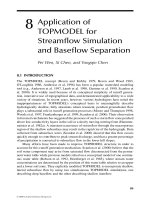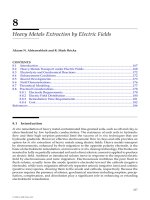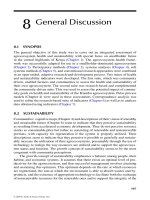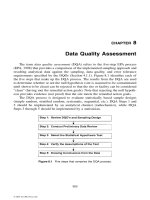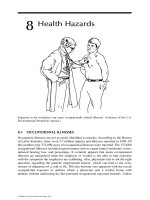Marketing Communications - Chapter 8 doc
Bạn đang xem bản rút gọn của tài liệu. Xem và tải ngay bản đầy đủ của tài liệu tại đây (1.41 MB, 30 trang )
© 2010 South-Western, a part of Cengage Learning
All rights reserved.
PowerPoint Presentation by Charlie Cook
The University of West Alabama
Eighth Edition
Effective and Creative
Advertising Messages
CHAPTER
8
1. Appreciate the factors that promote effective, creative,
and “sticky” advertising.
2. Describe the features of a creative brief.
3. Explain alternative creative styles of advertising
messages.
4. Understand the concept of means-end chains and
their role in advertising strategy.
5. Appreciate the MECCAS model and its role in guiding
message formulation.
6. Recognize the role of corporate image and issue
advertising.
Chapter Objectives
After reading this chapter you should be able to:
© 2010 South-Western, a part of Cengage Learning. All rights reserved. 8–2
© 2010 South-Western, a part of
Cengage Learning. All rights
reserved. 8–3
Creating Effective Advertising
Creating Effective Advertising
Accomplishment
(Output Perspective)
Composition
(Input Perspective)
Meaning of
Effective Advertising
© 2010 South-Western, a part of
Cengage Learning. All rights
reserved. 8–4
Effective Advertising
Effective Advertising
Takes the
Consumer’s View
Extends from
Sound Marketing
Strategy
Doesn’t Overwhelm
the Strategy
Delivers on
Its Promises
Breaks through
the Clutter
© 2010 South-Western, a part of
Cengage Learning. All rights
reserved. 8–5
Creativity: The CAN Elements
Creativity: The CAN Elements
Connectedness
Appropriateness
Novelty
The CAN Elements
of Creative Ads
© 2010 South-Western, a part of
Cengage Learning. All rights
reserved. 8–6
Getting Messages to “Stick”
Getting Messages to “Stick”
•
Characteristics of Sticky Ads
Characteristics of Sticky Ads
Their audience readily comprehends the advertiser’s
Their audience readily comprehends the advertiser’s
intended message
intended message
They are remembered
They are remembered
They change the target audience’s brand-related
They change the target audience’s brand-related
opinions or behavior
opinions or behavior
They have lasting impact: they stick
They have lasting impact: they stick
© 2010 South-Western, a part of
Cengage Learning. All rights
reserved. 8–7
Sticky Messages: SUCCESs
Sticky Messages: SUCCESs
Common Elements
of Sticky Ads
Unexpectedness
Simplicity
Concreteness
Storytelling
Emotionality
Credibility
© 2010 South-Western, a part of
Cengage Learning. All rights
reserved. 8–8
Illustrations of the Aflac Advertising Campaign
with the “Spokesduck.”
Figure 8.1
© 2010 South-Western, a part of
Cengage Learning. All rights
reserved. 8–9
Advertising Successes and Mistakes
Advertising Successes and Mistakes
•
Value Proposition
Value Proposition
Is the essence of a message and the reward to the
Is the essence of a message and the reward to the
consumer for investing his or her time attending to an
consumer for investing his or her time attending to an
advertisement
advertisement
The reward could be information about the product or
The reward could be information about the product or
just an enjoyable experience
just an enjoyable experience
Research indicates that starting with a strong selling
Research indicates that starting with a strong selling
proposition substantially increases the odds of
proposition substantially increases the odds of
creating effective advertisements
creating effective advertisements
© 2010 South-Western, a part of
Cengage Learning. All rights
reserved. 8–10
Combination of Message Convincingness
and Execution Quality
Figure 8.2
© 2010 South-Western, a part of
Cengage Learning. All rights
reserved. 8–11
Advertising Successes and Mistakes (cont’d)
Advertising Successes and Mistakes (cont’d)
Successful
Successful
Campaigns
Campaigns
Agency
Agency
Mistakes
Mistakes
Marketing
Marketing
Mistakes
Mistakes
Result from both the brand management team and
the creative team having done their work well
Occur when the brand manager fails to distinguish
the brand from competitive offerings
Result from the ad agency’s inability to design an
effective execution, even though its brand
management client has a convincing message
Complete
Complete
Disasters
Disasters
Are caused by poor value propositions and
mediocre executions
© 2010 South-Western, a part of
Cengage Learning. All rights
reserved. 8–12
Constructing a Creative Brief
Constructing a Creative Brief
Item
Item
Question
Question
Background
Background
What is the background to this job?
What is the background to this job?
Target Audience
Target Audience
Whom do we need to reach with the ad campaign?
Whom do we need to reach with the ad campaign?
Thoughts and
Thoughts and
Feelings
Feelings
What do members of the target audience currently think and
What do members of the target audience currently think and
feel about our brand?
feel about our brand?
Objectives and
Objectives and
Measures
Measures
What do we want the target audience to think or feel about the
What do we want the target audience to think or feel about the
brand, and what measurable effects is the advertising
brand, and what measurable effects is the advertising
designed to accomplish?
designed to accomplish?
Behavioral Outcome
Behavioral Outcome
What do we want the target audience to do?
What do we want the target audience to do?
Positioning
Positioning
What is the brand positioning?
What is the brand positioning?
Message and
Message and
Medium
Medium
What general message is to be created, and what medium is
What general message is to be created, and what medium is
most appropriate for reaching the target audience?
most appropriate for reaching the target audience?
Strategy
Strategy
What is the strategy?
What is the strategy?
Nitty-Gritty Details
Nitty-Gritty Details
When (deadline) and how much (budget)?
When (deadline) and how much (budget)?
© 2010 South-Western, a part of
Cengage Learning. All rights
reserved. 8–13
Alternative Styles of Creative Advertising
Alternative Styles of Creative Advertising
•
Functionally Oriented Advertising
Functionally Oriented Advertising
Appeals to consumers’ needs for tangible, physical,
Appeals to consumers’ needs for tangible, physical,
and concrete benefits
and concrete benefits
•
Symbolically or Experientially Oriented
Symbolically or Experientially Oriented
Advertising
Advertising
Is directed at psychosocial needs
Is directed at psychosocial needs
•
Category-Dominance Advertising
Category-Dominance Advertising
Does not necessarily use any particular type of
Does not necessarily use any particular type of
appeal to consumers but is designed to achieve an
appeal to consumers but is designed to achieve an
advantage over competitors in the same product
advantage over competitors in the same product
category
category
© 2010 South-Western, a part of
Cengage Learning. All rights
reserved. 8–14
Styles of Creative Advertising
Table 8.1
© 2010 South-Western, a part of
Cengage Learning. All rights
reserved. 8–15
Creative Advertising Styles
Creative Advertising Styles
Creative Style
Creative Style
Strategy
Strategy
Unique Selling
Unique Selling
Proposition
Proposition
Identifying an important difference that makes a brand unique
Identifying an important difference that makes a brand unique
and supports a claim that competitors cannot match
and supports a claim that competitors cannot match
Brand Image
Brand Image
Developing an image or identity for a brand by associating the
Developing an image or identity for a brand by associating the
brand with
brand with
symbols
symbols
that provide a transformational context
that provide a transformational context
Resonance
Resonance
Attempting to match “patterns” in an advertisement with the
Attempting to match “patterns” in an advertisement with the
target audience’s stored experiences
target audience’s stored experiences
Emotional
Emotional
Aiming to reach the consumer at a visceral level through the use
Aiming to reach the consumer at a visceral level through the use
of emotional strategy
of emotional strategy
Generic
Generic
Making no attempt to differentiate the dominant brand from
Making no attempt to differentiate the dominant brand from
competitive offerings or to claim superiority
competitive offerings or to claim superiority
Preemptive
Preemptive
Making a generic-type claim but doing so with an assertion of
Making a generic-type claim but doing so with an assertion of
superiority
superiority
© 2010 South-Western, a part of
Cengage Learning. All rights
reserved. 8–16
Illustration of
Resonance
Creative Strategy
Figure 8.3
© 2010 South-Western, a part of
Cengage Learning. All rights
reserved. 8–17
Illustration of
Emotional
Creative Strategy
Figure 8.4
© 2010 South-Western, a part of
Cengage Learning. All rights
reserved. 8–18
Section Summary
Section Summary
•
An advertiser might use two or more styles
An advertiser might use two or more styles
simultaneously.
simultaneously.
•
Some experts believe that advertising is most
Some experts believe that advertising is most
effective when it addresses both functional
effective when it addresses both functional
product and symbolic benefits.
product and symbolic benefits.
•
Effective advertising must establish a clear
Effective advertising must establish a clear
meaning of what the brand is and how it
meaning of what the brand is and how it
compares to competitive offerings.
compares to competitive offerings.
© 2010 South-Western, a part of
Cengage Learning. All rights
reserved. 8–19
Means-End Chaining and the Method
Means-End Chaining and the Method
of Laddering as Guides to Creative
of Laddering as Guides to Creative
Advertising Formulation
Advertising Formulation
•
Means-End Chain
Means-End Chain
Represents the linkages among brand attributes, the
Represents the linkages among brand attributes, the
consequences obtained from using the brand and
consequences obtained from using the brand and
“consuming” the attributes, and the personal values
“consuming” the attributes, and the personal values
that the consequences reinforce
that the consequences reinforce
© 2010 South-Western, a part of
Cengage Learning. All rights
reserved. 8–20
Means-End Chain
Means-End Chain
•
Attributes
Attributes
Features or aspects of advertised brands
Features or aspects of advertised brands
•
Consequences
Consequences
What consumers hope to receive (benefits) or avoid
What consumers hope to receive (benefits) or avoid
(detriments) when consuming brands
(detriments) when consuming brands
•
Values
Values
Enduring beliefs people hold regarding what is
Enduring beliefs people hold regarding what is
important in life
important in life
Brand attributes and the consequences of
consuming these attributes are the means
whereby people achieve valued ends
© 2010 South-Western, a part of
Cengage Learning. All rights
reserved. 8–21
Ten Universal Values
Table 8.2
© 2010 South-Western, a part of
Cengage Learning. All rights
reserved. 8–22
A MECCAS* Model Conceptualization
of Advertising Strategy
Table 8.3
* Means-End Conceptualization of Components for Advertising Strategy
© 2010 South-Western, a part of
Cengage Learning. All rights
reserved. 8–23
MECCAS
Illustration for
Self-Direction
Value
Figure 8.5
© 2010 South-Western, a part of
Cengage Learning. All rights
reserved. 8–24
MECCAS
Illustration for
Hedonism
Value
Figure 8.6
© 2010 South-Western, a part of
Cengage Learning. All rights
reserved. 8–25
MECCAS
Illustration for
Achievement
Value
Figure 8.7



